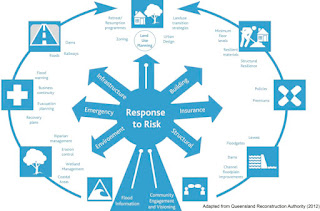Toward a Sustainable and Resilient Future
Authors: Sơn, Võ Thanh, Hồi, Nguyễn Chu, Nghi, Trần Hữu, Quang, Bùi Công Sơn, Nguyễn Danh Thắng, Lê Văn Thắng, Hoàng Văn Tuấn, Lê Anh Tuyến, Nghiêm Phương
Based on the results achieved in Chapters 3, 4, 5, 6, 7, Chapter 8 is considered to be an orientation toward a sustainable development future which is resistant to the effects of climate change extremes in Vietnam. With this purpose, this chapter presents the research on “Relationship between Disaster Risk Management and Sustainable Development”, “Integration of Short- and Long-term Responses to Extreme Events”, and “Relationship between Disaster Risk Management, Adaptation to Climate Extremes, and Mitigation of Greenhouse Gas Emissions”. These issues are the theoretical and practical basis to help policy makers in Vietnam define a more specific vision for future development. Remarks drawn from these studies are: Conservation of natural capitals such as biodiversity and ecosystem services, applied science and technology play an important role in directing and harmonizing the nation’s socio-economic development goals; Integrating disaster risk reduction and climate change adaptation is an important issue in adjusting socio-economic policies and developing sectoral strategies, including connecting short and long-term activities through a synchronous implementation process, in order to bring about the highest efficiency for the present and future; Enabling economic and social development as well as maintaining environmental security are essential to the implementation of sustainable development goals while Viet Nam is facing challenges of water shortage, degradation of land resources and biodiversity; In Viet Nam, the impact of disaster risk and climate change are considered to be at the tolerant threshold, particularly concerning the vulnerability of affected populations, such as the poor, women, children and ethnic minorities as well as the most heavily affected industries such as agriculture and aquaculture, transportation and infrastructure; and The role and awareness of leaders at all levels, as well as the adoption of appropriate approaches, such as adaptive management, will contribute to promote social change in order to adapt more effectively to climate change and and disaster risk reduction. Based on the aforementioned findings, Chapter 8 provides directions for “Planning for Proactive, Long-term Resilience to Future Climate Extremes” and “Synergy between Disaster Risk Management and Climate Change Adaptation for a Resilient and Sustainable Future”. From the practical disaster risk management and climate change adaptation in Vietnam, three lessons were summarized, namely: 1) Strong commitment of the Government towards disaster risk reduction and climate extremes in order to proactively adapt to climate change; 2) Awareness raising, capacity development associated with the mobilization of community participation in disaster risk reduction, extreme events and climate change adaptation; and 3) Coordinating and promoting national capacity and international cooperation...
| Keywords: | Resilient;Sustainable |
| Issue Date: | 2015 |
| Publisher: | Viet Nam Publishing House of Natural Resources, Environment and Cartography |
| Citation: | Vo Thanh Son, Nguyen Chu Hoi, Tran Huu Nghi, Bui Cong Quang, Nguyen Danh Son, Le Van Thang, Hoang Van Thang, Le Anh Tuan, Nghiem Phuong Tuyen, 2015: Toward a Sustainable and Resilient Future. In: Viet Nam Special Report on Managing the Risks of Extreme Events and Disasters to Advance Climate Change Adaptation [Tran Thuc, Koos Neefjes, Ta Thi Thanh Huong, Nguyen Van Thang, Mai Trong Nhuan, Le Quang Tri, Le Dinh Thanh, Huynh Thi Lan Huong, Vo Thanh Son, Nguyen Thi Hien Thuan, Le Nguyen Tuong], Viet Nam Publishing House of Natural Resources, Environment and Cartography, Ha Noi, Viet Nam, pp 305-346 |
| URI: | http://repository.vnu.edu.vn/handle/VNU_123/10153 |
| Appears in Collections: | CRES - Papers |




Nhận xét
Đăng nhận xét